RAILWAYS WITH ZIG ZAGS WORLDWIDE
ASIA
There are many websites devoted to Indian Railways, these are but two:
Indian Railways Fan
Club
Indian Steam Railway Society
Mike's Railway History - Modern Transport in India - 1935
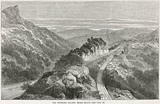
 India - Bhore Ghat, near Mumbai (Bombay) on the Great
Indian Peninsula Railway's main line from Mumbai to Pune (Poona). There was a
reversing station near Khandala and Lonavala, half a zig zag, it used a grade of
1 in 37. It would have been known to John Whitton as the railway's opening was
reported in detail in the Sydney Morning Herald in July 1863. This was
superseded by tunnels and deviations 1928. It is possible that John Whitton may
have seen it as he returned from a visit to England via Bombay in 1868. Quote
from a web page: "The century-old but now-disused reversing station of Bhore Ghat
near Khandala, a heritage structure where the pioneering broad-gauge Great
Indian Peninsula Railway from Bombay to Poona once zig-zagged to gain height,
was in summer 2002 being demolished to make way for a highway.
India - Bhore Ghat, near Mumbai (Bombay) on the Great
Indian Peninsula Railway's main line from Mumbai to Pune (Poona). There was a
reversing station near Khandala and Lonavala, half a zig zag, it used a grade of
1 in 37. It would have been known to John Whitton as the railway's opening was
reported in detail in the Sydney Morning Herald in July 1863. This was
superseded by tunnels and deviations 1928. It is possible that John Whitton may
have seen it as he returned from a visit to England via Bombay in 1868. Quote
from a web page: "The century-old but now-disused reversing station of Bhore Ghat
near Khandala, a heritage structure where the pioneering broad-gauge Great
Indian Peninsula Railway from Bombay to Poona once zig-zagged to gain height,
was in summer 2002 being demolished to make way for a highway.
Lots of pictures including some during construction.
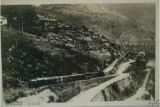 India - Darjeeling Himalayan Railway, Northern India. Opened in 1881.
2' 0" gauge, 88km (55 miles) long, the railway rises from 533 ft at Sukna to
7407 at Ghum, in only 40 miles. The ruling grade is variously quoted at 1 in 16
or or 1 in 18. The sharpest curve is 59ft radius. There are five zig-zags and
four loops, two of them double spirals.
India - Darjeeling Himalayan Railway, Northern India. Opened in 1881.
2' 0" gauge, 88km (55 miles) long, the railway rises from 533 ft at Sukna to
7407 at Ghum, in only 40 miles. The ruling grade is variously quoted at 1 in 16
or or 1 in 18. The sharpest curve is 59ft radius. There are five zig-zags and
four loops, two of them double spirals.
One of the only two railway sites listed (in 1999) under UNESCO's World
Heritage Sites. The citation says: "The Darjeeling Himalayan Railway is the
first, and still the most outstanding, example of a hill passenger railway.
Opened in 1881, it applied bold, ingenious engineering solutions to the problem
of establishing an effective rail link across a mountainous terrain of great
beauty. It is still fully operational and retains most of its original
features."
The other UNESCO listed railway is the Semmering-Railway in Austria.
There are a number of English Language sites for the Darjeeling
Railway:
The Darjeeling Toy Train - Zubin Medora's Site
Darjeeling Himalayan Railway Society -
UK
Mike's Railway History - Darjeeling Himalayan Railway
Information as it was in the 1930s.
Mike's
Railway History - Hill Railways of India Information on hill railways in
what is now India, Pakistan, and Burma as in 1935.
 Pakistan, Khyber Pass
Railway, built 1920-5 by the British to connect India with Afghanistan. It
starts from Peshawar in the North West Frontier Province. A remarkable
construction, particularly the section through the Hindu Kush mountains between
Jamrud (1500ft) and Landi Kotal (3500ft) a distance of 20.5 miles. It has a
ruling gradient of three percent (1 in 33) between Jamrud and Landi Kotal, 3494
feet above sea level, a rise of nearly 2000 feet in twenty one miles. The track
then drops 872 feet in four and a half miles to Landi Kotal, a gradient of 1 in
25. At one point, the track climbs 130 meters in little more than a kilometer
(425 feet in 0.7 miles) by means of the heart stopping Chungai Spur. This is a
W-shaped section of track with two cliff-hanging reversing stations, at which
the train wheezes desperately before shuddering to a stop and hacking away from
the brink.
Pakistan, Khyber Pass
Railway, built 1920-5 by the British to connect India with Afghanistan. It
starts from Peshawar in the North West Frontier Province. A remarkable
construction, particularly the section through the Hindu Kush mountains between
Jamrud (1500ft) and Landi Kotal (3500ft) a distance of 20.5 miles. It has a
ruling gradient of three percent (1 in 33) between Jamrud and Landi Kotal, 3494
feet above sea level, a rise of nearly 2000 feet in twenty one miles. The track
then drops 872 feet in four and a half miles to Landi Kotal, a gradient of 1 in
25. At one point, the track climbs 130 meters in little more than a kilometer
(425 feet in 0.7 miles) by means of the heart stopping Chungai Spur. This is a
W-shaped section of track with two cliff-hanging reversing stations, at which
the train wheezes desperately before shuddering to a stop and hacking away from
the brink.

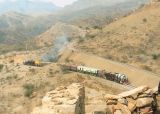 West of Landi Kotal the railway descends to Landi Khana 2,600
feet above sea level, a drop of 900 feet in only 5.25 miles. There are another
two reversing stations on this part. It was completed in 1926, but was closed in
1932 at the request of the Afghan government.
West of Landi Kotal the railway descends to Landi Khana 2,600
feet above sea level, a drop of 900 feet in only 5.25 miles. There are another
two reversing stations on this part. It was completed in 1926, but was closed in
1932 at the request of the Afghan government.
Features of the whole line
include four reversing stations, thirty four tunnels, ninety two bridges and
culverts, six ordinary crossing and four locomotive watering stations.
Wikipedia in English
Wikipedia in German.
It gives more information about the line layout. Translation of this page says 2 switchbacks before Shahgai. For strategic reasons the line
is maintained.
Khyber Pass Railway
Khyber Steam Engine Safari
Woman drove first train in Khyber Agency
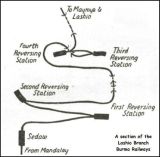 Burma (Myanmar). Two metre gauge railway lines in
Burma contained zig zags: the Mandalay - Maymyo - Lashio line and the
Thazi - Taunggyi line near Kalaw, both metre gauge, both built in the
1890s.
Burma (Myanmar). Two metre gauge railway lines in
Burma contained zig zags: the Mandalay - Maymyo - Lashio line and the
Thazi - Taunggyi line near Kalaw, both metre gauge, both built in the
1890s.
The Mandalay - Maymyo - Lashio - line between Sedaw and Maymyo
had three zig zags up the face of a precipitous hill, with four reversing
stations and gradients of 1 in 25 between.
The Thazi - Taunggyi line,
also known as the Southern Shan States line had four reversing stations and a
spiral, the gradient was again 1 in 25.
Mike's
Railway History - Railways of Burma
China, Beijing-Kalgan Railway. Built 1901-1909 in
standard gauge, it crosses the Nankow Pass, which the Great Wall of China also
crosses. The line climbed 1641 feet in under 12 miles. The gradient was mostly 1
in 40, with occasional sections of 1 in 30. The line included 4 tunnels and a
reversing station at Qinglongqiao - half a zig zag. The line was rebuilt,
eliminating "the most demanding parts of the line in operational terms, and
hence the most interesting aesthetically and technically". However the
reversing station at Qinglongqiao remains, built 1905-09. Trains use a locomotive at each end
to negotiate it. It is in the line between Beijing and Badaling, to serve the Great
Wall of China.
Qinglongqiao Reversing Station
Mike's Railway History - Railways of China
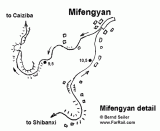 China, Jiayang Power Company Railway, Shibangxi, Sichuan Province. A
picturesque isolated narrow gauge (2'6" - 762mm) railway running between
Huanngchingjing and Shixi, serving several local coal mines. There is a
reversing station at Mifung (Mifeng), together with a tunnel and a scenic
curve.
China, Jiayang Power Company Railway, Shibangxi, Sichuan Province. A
picturesque isolated narrow gauge (2'6" - 762mm) railway running between
Huanngchingjing and Shixi, serving several local coal mines. There is a
reversing station at Mifung (Mifeng), together with a tunnel and a scenic
curve.
John Raby's diary
China Narrow Gauge Paradise
Jiayang Coal
Railway (Sichuan)
Steam South
of Beijing, December 2001 Part 1
Shibanxi in
Transition 2006
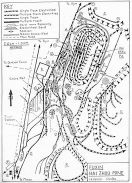 China, Hai Zhou
Coal Mine, Fuxin, Liaoning Province, north-eastern China, Open Cast mine,
42' n 121'30", about 150km west of Shenyang the capital, 120 km north of
Jinzhou, over 400km NE Beijing. Open cast mine about 4km x 2km x 250m deep. From
the layout there would appear to be 7-8 reversing stations / zig zags. Electric
locomotives are used to carry most of the coal from the pit, steam locomotives
may be used for track maintenance. Levels are triple tracked.
China, Hai Zhou
Coal Mine, Fuxin, Liaoning Province, north-eastern China, Open Cast mine,
42' n 121'30", about 150km west of Shenyang the capital, 120 km north of
Jinzhou, over 400km NE Beijing. Open cast mine about 4km x 2km x 250m deep. From
the layout there would appear to be 7-8 reversing stations / zig zags. Electric
locomotives are used to carry most of the coal from the pit, steam locomotives
may be used for track maintenance. Levels are triple tracked.
Steam in
Northern China, March 2002
Private
lines of Fuxin mining bureau
 Taiwan, Alishan
Forest Railway, in South Taiwan, built by the Japanese 1899-1914, in 2'6"
(762mm) gauge, total length 71.4km, with a gradient of 6.25% (1 in 16). It
rivals the Darjeeling Railway and one of the TransAndean lines in gradient
steepness. It is now mainly a tourist railway. In earlier times Shay Locomotives
made by Lima in USA were used, now the line is diesel hauled, there may be a few
Shay hauled specials. During the 4 hour journey the train climbs from 30 - 2216m
above sea level. Along the line there are two zig-zags (4 switchbacks), 49
tunnels and 77 bridges and a triple loop around a mountain where the line climbs
200m in 5km. The line was begun at Chia-I (Chiai)(Chiayi) just north of the
Tropic of Cancer, reached to Erwanping by 1912, and Alishan by 1914.
Taiwan, Alishan
Forest Railway, in South Taiwan, built by the Japanese 1899-1914, in 2'6"
(762mm) gauge, total length 71.4km, with a gradient of 6.25% (1 in 16). It
rivals the Darjeeling Railway and one of the TransAndean lines in gradient
steepness. It is now mainly a tourist railway. In earlier times Shay Locomotives
made by Lima in USA were used, now the line is diesel hauled, there may be a few
Shay hauled specials. During the 4 hour journey the train climbs from 30 - 2216m
above sea level. Along the line there are two zig-zags (4 switchbacks), 49
tunnels and 77 bridges and a triple loop around a mountain where the line climbs
200m in 5km. The line was begun at Chia-I (Chiai)(Chiayi) just north of the
Tropic of Cancer, reached to Erwanping by 1912, and Alishan by 1914.
Taiwan
Information
Alishan Forest Railway Journey Description
Shay
Locomotives on the Alishan Forest Railway
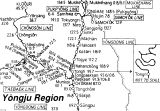 South Korea, Taebaek - Donghae Line - gauge 4' 8.5"
(1435mm), length about 50km.( There is a problem in English with Korean place
names as there may be several ways of spelling them.)
South Korea, Taebaek - Donghae Line - gauge 4' 8.5"
(1435mm), length about 50km.( There is a problem in English with Korean place
names as there may be several ways of spelling them.)
In the province of
Gangwon (Kangwon), in the North East of the country there is a range of
mountains not far from the coast. A railway line runs from Gangneung (Kangnung)
southward connecting with the ports of Mukhu and Donghae (Tonghae). The line
forks slightly north of Donghae heading inland through the Taebaek (Taebeck)
mountains to the mining town of Taebaek before continuing via a couple of
spirals to Seoul.
From Donghae the line climbs through a a deep steep valley.
About about 40km from Donghae (10km from Taebaek) there is a zig zag (two
switchbacks) with approximately 500m between reversing stations. The line was
built in 1963. The line was electrified in 1975 although some trains may be still
diesel hauled.
Yeongdong Line.
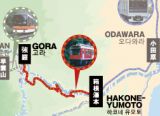 Japan (South) - Hakone Tozan Line
The line was built 1917-1930. The railroad can climb 1m for every 12.5m horizontally, a maximum slope of 8%.
The line crosses Fuji-Hakone-Izu National Park, it was carefully designed to limit the impact on scenery.
Due to the difficult terrain, the line has three switchbacks. See diagram right.
Japan (South) - Hakone Tozan Line
The line was built 1917-1930. The railroad can climb 1m for every 12.5m horizontally, a maximum slope of 8%.
The line crosses Fuji-Hakone-Izu National Park, it was carefully designed to limit the impact on scenery.
Due to the difficult terrain, the line has three switchbacks. See diagram right.
Hakaone
Tozan Mountain Railway
Japan (South) - Hisatsu Line on Kyushu.
At Okoba it has a zig zag that leads into a spiral, and at Masaki it has a zig zag. See Wikipedia diagram.
Japan - Tateyama Sabo Erosion Control Works Service Train The line transports materials and workers for
construction/conservation work; not open to the public. Built 1926-31, 200mm Gauge.
Because of its historical significance, the line is registered as a Registered Monument by the Law for
the Protection of Cultural Properties. Originally part of the line was a rack railway. Following decay during WWII that
section was replaced by a cable car. In 1965 that section was replaced by a railway with 18 zig zags. During 1998-2007
some zig zags were replaced by tunnels. The line has one of
the largest number of railway zig zags in the world.
Lebanon - Lebanese State Railway Company. After 1891 a
French-Belgian group built the Beirut - Damascus line, opened in 1895. Because
of the steep gradient behind Beirut the Abt system was used for part of the
line. There were two reversing stations at Chouit-Araye and Aley. The highest
level reached was 5059 feet, often covered with snow. Gauge was 1050mm.
More information on Middle Eastern Railways
Not a Zig Zag but sometimes described a switchback or zigzag(s)
in the sense of horseshoe/hairpin bends:
Matheran Hill Railway, Maharashtra, India Built 1901-07 between Neral & Matheran, its
2'0" (610cm)gauge easily included several switchbacks/loopbacks. Ruling gradient of 1 in 20.
Rob Dichinson's page on Matheran Hill Railway
Matheran Light Railway
Matheran Hill Railway
Updated 10 December 2011

 India - Bhore Ghat, near Mumbai (Bombay) on the Great
Indian Peninsula Railway's main line from Mumbai to Pune (Poona). There was a
reversing station near Khandala and Lonavala, half a zig zag, it used a grade of
1 in 37. It would have been known to John Whitton as the railway's opening was
reported in detail in the Sydney Morning Herald in July 1863. This was
superseded by tunnels and deviations 1928. It is possible that John Whitton may
have seen it as he returned from a visit to England via Bombay in 1868. Quote
from a web page: "The century-old but now-disused reversing station of Bhore Ghat
near Khandala, a heritage structure where the pioneering broad-gauge Great
Indian Peninsula Railway from Bombay to Poona once zig-zagged to gain height,
was in summer 2002 being demolished to make way for a highway.
India - Bhore Ghat, near Mumbai (Bombay) on the Great
Indian Peninsula Railway's main line from Mumbai to Pune (Poona). There was a
reversing station near Khandala and Lonavala, half a zig zag, it used a grade of
1 in 37. It would have been known to John Whitton as the railway's opening was
reported in detail in the Sydney Morning Herald in July 1863. This was
superseded by tunnels and deviations 1928. It is possible that John Whitton may
have seen it as he returned from a visit to England via Bombay in 1868. Quote
from a web page: "The century-old but now-disused reversing station of Bhore Ghat
near Khandala, a heritage structure where the pioneering broad-gauge Great
Indian Peninsula Railway from Bombay to Poona once zig-zagged to gain height,
was in summer 2002 being demolished to make way for a highway.
 Pakistan, Khyber Pass
Railway, built 1920-5 by the British to connect India with Afghanistan. It
starts from Peshawar in the North West Frontier Province. A remarkable
construction, particularly the section through the Hindu Kush mountains between
Jamrud (1500ft) and Landi Kotal (3500ft) a distance of 20.5 miles. It has a
ruling gradient of three percent (1 in 33) between Jamrud and Landi Kotal, 3494
feet above sea level, a rise of nearly 2000 feet in twenty one miles. The track
then drops 872 feet in four and a half miles to Landi Kotal, a gradient of 1 in
25. At one point, the track climbs 130 meters in little more than a kilometer
(425 feet in 0.7 miles) by means of the heart stopping Chungai Spur. This is a
W-shaped section of track with two cliff-hanging reversing stations, at which
the train wheezes desperately before shuddering to a stop and hacking away from
the brink.
Pakistan, Khyber Pass
Railway, built 1920-5 by the British to connect India with Afghanistan. It
starts from Peshawar in the North West Frontier Province. A remarkable
construction, particularly the section through the Hindu Kush mountains between
Jamrud (1500ft) and Landi Kotal (3500ft) a distance of 20.5 miles. It has a
ruling gradient of three percent (1 in 33) between Jamrud and Landi Kotal, 3494
feet above sea level, a rise of nearly 2000 feet in twenty one miles. The track
then drops 872 feet in four and a half miles to Landi Kotal, a gradient of 1 in
25. At one point, the track climbs 130 meters in little more than a kilometer
(425 feet in 0.7 miles) by means of the heart stopping Chungai Spur. This is a
W-shaped section of track with two cliff-hanging reversing stations, at which
the train wheezes desperately before shuddering to a stop and hacking away from
the brink.






